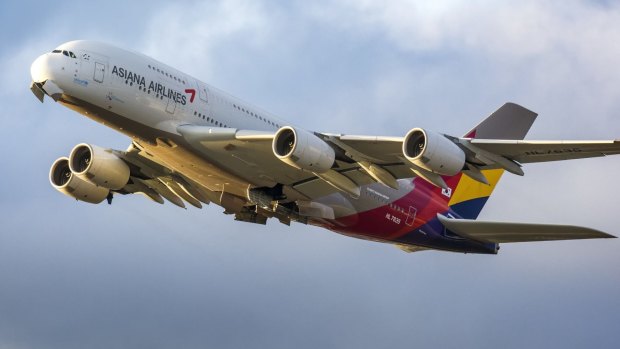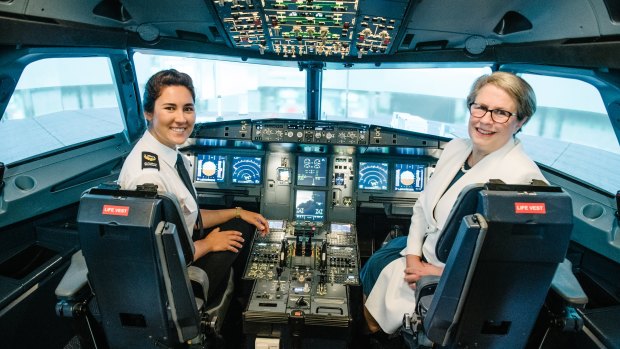This was published 3 years ago
Airlines pilots and COVID-19 travel restrictions: Why Asiana pilots are flying empty Airbus A380s in circles
On May 6, 2020, plane spotters at Seoul Incheon Airport (ICN) noticed an Airbus A380 taking off. That was rare enough to generate some excitement since with just a few exceptions, the world's entire fleet of A380s was sitting idle. Even more curious, that same A380 landed after about 20 minutes, then took off after a short pause and landed again 20 minutes later.
That day the same aircraft made nine such flights, flying a loop from ICN and back again. During the following two days it recorded 17 similar flights. And apart from its flight crew, the aircraft was completely empty.
The A380 belonged to South Korea's Asiana Airlines, and all it was doing was complying with aviation industry regulations. Each flight was another tick in the box that requires commercial pilots to prove their proficiency every 90 days, and would allow Asiana to resume A380 flights when the fleet is once again operational.

Without access to a simulator, South Korea's Asiana Airlines has been forced to fly its A380s in circles to keep its pilots certified.Credit: Getty Images
Under normal circumstances, Asiana pilots could have their proficiency assessed using a flight simulator located in Thailand but the pandemic had slammed that door shut. If Asiana wanted to keep its pilots fully certified to operate its six A380s, it had no choice but to put them in the cockpit and practice their take-offs and landings in the world's largest passenger aircraft.
The pilot's skill set
The famous concert pianist Jan Paderewski once said "If I don't practice for one day, I know it; if I don't practice for two days, the critics know it; if I don't practice for three days, the audience knows it."

Aviation student Eliza Terry and Vice-Chancellor Professor Geraldine Mackenzie in the University of Southern Queensland's new Airbus A320 flight simulator.
Most professions don't require diligence on that level, but whether you're a plumber, a cardiac surgeon or a commercial airline pilot, day-to-day, hands-on experience is crucial. Skills lapse with time and that's less than ideal for a pilot who might be operating an aircraft with 300-plus people on board. In most cases, it takes a minimum of five years to gain the qualifications and experience required of an airline pilot. Keeping that expertise up to par is key and there are stringent regulations requiring pilots to undergo regular assessments, known as "recency" in the trade.
The rules that govern recency are set by just a few regulatory agencies such as the Federal Aviation Administration in the US, the European Aviation Safety Agency and the Civil Aviation Safety Authority (CASA) in Australia, but they don't differ greatly from one country to the next.
Among the assessments that a pilot must pass to maintain their certification to fly a certain aircraft type, they must have carried out a minimum of three take-offs, approaches and landings on that aircraft in the previous 90 days. That includes flying under Instrument Flight Rules (IFR) to allow for night flights, or when visibility is restricted. Every six months commercial pilots are required to take a proficiency check, an assessment of skills and knowledge in a particular operational area.
As well as in the cockpit of an aircraft during routine operations these assessments are frequently carried out in a Level D flight simulator. These are ultra-realistic training situations with flight controls, sound effects and sensations designed to re-create the cockpit experience, right down to a digitised version of what the pilot would be seeing out the window in a real environment.
During the take-off roll the seat pushes back, when the "aircraft" is braked after touchdown, the shakes happen. Apart from the fact that even a total landing wipeout won't kill anyone, these simulators are every bit as real as the real thing.
The new rules for pilots
While flight simulators are approved for pilot certification by regulators, there's a catch. There are only so many of these $30 million devices (the University of Southern Queensland unveiled its new Airbus A320 simulator earlier this week). They tend to be located in simulator centres – often airline hubs, and at the moment some of those are not accessible.
On the other hand, the world has close to 300,000 active commercial airline pilots and most of them have not been sitting in cockpits. Haven't been since the airline industry went into free fall under the impact of the pandemic and aircraft movements around the world fell by over 90 per cent in some periods.
One of the outcomes has been that many of those stood-down pilots have not completed three take-offs, approaches and landings within the required three-month period, yet airlines need those pilots shovel-ready if they have any hope of recovering.
In recognition of the difficulties facing many pilots who have been stood down during the pandemic, in the US the FAA has extended by three months the proficiency checks, medical checks, flight review and instrument currency requirements that pilots would undergo in the normal course of events. Pilots whose certification in those areas expired in the period March-June 2020 have another three months to complete these requirements.
In Australia, CASA has exempted pilots for provisions relating to medical certificates, proficiency checks and flight reviews for periods between one and six months, provided they hold a flight crew licence that was valid on March 31, 2020. There are conditions, for example, the exemption for proficiency checks and flight reviews applies for one to three months provided the candidate has not failed a proficiency check or flight review.
Whether this has any impact on passenger safety will play out in the longer term, but typically pilots are self-motivated, disciplined, can-do people who don't sit around. Hopefully they're working to stay on top of their game, poring over their flight manuals, doing spin classes at the gym - and maybe even keeping their skills sharp on Microsoft Flight Simulator.
See also: First Emirates A380 superjumbo returns to the skies after fleet grounding
See also: Fuselage for the last A380 superjumbo squeezes through French village
Sign up for the Traveller newsletter
The latest travel news, tips and inspiration delivered to your inbox. Sign up now.